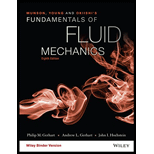
Concept explainers
The local component of acceleration in
The convective component of acceleration in
The local component of acceleration in
The convective component of acceleration in
The magnitude and direction of velocity at
The magnitude of acceleration at
The direction of acceleration at
Answer to Problem 1P
The local component of acceleration in
The local component of acceleration in
The convective component of acceleration in
The convective component of acceleration in
The magnitude of acceleration at
The direction of acceleration at
Explanation of Solution
Write the expression of velocity in a certain two dimensional flow field.
Here, the displacement in
Write the expression of velocity.
Here, the
Compare the term of unit vector from Equation (I) and (II).
Write the expression of local component of acceleration in
Write the expression of local component of acceleration in
Write the expression of convective acceleration in
Write the expression of convective acceleration in
Write the expression of acceleration.
Substitute
Write the expression of acceleration.
Here, the acceleration component in
Write the expression of direction of acceleration.
Write the expression of magnitude of the acceleration.
Conclusion:
Substitute
Thus, the local component of acceleration in
Substitute
Thus, the local component of acceleration in
Substitute
Thus, the convective component of acceleration in
Substitute
Thus, the convective component of acceleration in
Substitute
Substitute
Substitute
Thus, The magnitude and direction of velocity at
Substitute
Compare the unit vector of Equation (XI) and (XIV).
Substitute
Thus, the magnitude of acceleration at
Substitute
Thus, the direction of acceleration at
Want to see more full solutions like this?
Chapter 6 Solutions
Munson, Young and Okiishi's Fundamentals of Fluid Mechanics, Binder Ready Version
 Elements Of ElectromagneticsMechanical EngineeringISBN:9780190698614Author:Sadiku, Matthew N. O.Publisher:Oxford University Press
Elements Of ElectromagneticsMechanical EngineeringISBN:9780190698614Author:Sadiku, Matthew N. O.Publisher:Oxford University Press Mechanics of Materials (10th Edition)Mechanical EngineeringISBN:9780134319650Author:Russell C. HibbelerPublisher:PEARSON
Mechanics of Materials (10th Edition)Mechanical EngineeringISBN:9780134319650Author:Russell C. HibbelerPublisher:PEARSON Thermodynamics: An Engineering ApproachMechanical EngineeringISBN:9781259822674Author:Yunus A. Cengel Dr., Michael A. BolesPublisher:McGraw-Hill Education
Thermodynamics: An Engineering ApproachMechanical EngineeringISBN:9781259822674Author:Yunus A. Cengel Dr., Michael A. BolesPublisher:McGraw-Hill Education Control Systems EngineeringMechanical EngineeringISBN:9781118170519Author:Norman S. NisePublisher:WILEY
Control Systems EngineeringMechanical EngineeringISBN:9781118170519Author:Norman S. NisePublisher:WILEY Mechanics of Materials (MindTap Course List)Mechanical EngineeringISBN:9781337093347Author:Barry J. Goodno, James M. GerePublisher:Cengage Learning
Mechanics of Materials (MindTap Course List)Mechanical EngineeringISBN:9781337093347Author:Barry J. Goodno, James M. GerePublisher:Cengage Learning Engineering Mechanics: StaticsMechanical EngineeringISBN:9781118807330Author:James L. Meriam, L. G. Kraige, J. N. BoltonPublisher:WILEY
Engineering Mechanics: StaticsMechanical EngineeringISBN:9781118807330Author:James L. Meriam, L. G. Kraige, J. N. BoltonPublisher:WILEY





